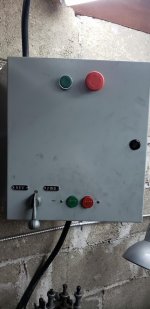Jarrod
Aluminum
- Joined
- Jul 18, 2011
- Location
- Toronto, ON
Yes, the contactor is on the input side. The vfd is rated for 2 hp (7.5A) and the motor is only a 1.5 hp (5.0 FLA). The setup is on my lathe. When I run the gearhead at the max speed (1500 rpm) it trips the contactor O/L after about a minute or less and I'm not even cutting anything! Running at 60 Hz I derated the vfd thermal protection for the smaller motor, but this is baffling me. I should not be drawing more than the vfd's input rating, using a smaller motor, should I?
I'm running out of ideas.
Any thoughts are appreciated.
Thanks.
I'm running out of ideas.
Any thoughts are appreciated.
Thanks.




